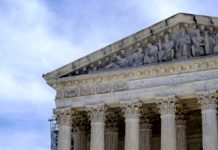
Feb. 28 (UPI) — The U.S. Supreme Court began hearing oral arguments Wednesday in a case that could define what voters can and can’t wear when voting in elections.
The court, which has long upheld politics-free buffer zones outside of polling places, heard the case of a Minnesota man who wore a shirt bearing a political slogan when he attempted to vote in 2010.
After being asked to cover up his Tea Party T-shirt, voter Bob Cilek was twice removed from the voting line. After returning with his attorney, he was permitted to vote, but his name and address were taken for possible legal prosecution.
Cilek and the Minnesota Voters Alliance sued on the basis of a violation of his constitutional free speech rights.
The Supreme Court justices asked a number of questions of David Breemer, Cilek’s attorney, and of Daniel Rogan, state’s attorney and senior attorney of the Hennepin County Attorney’s Office. Rogan argued that free speech is limited at a polling place, and that limits should be placed on promotion of causes and candidates.
Responding to questions from Justice Ruth Bader Ginsburg, he said that if a gay rights issue appears on the ballot, wearing a rainbow flag would be prohibited. Similarly, National Rifle Association regalia would not be allowed if a gun issue were on the ballot.
Justice Steven Breyer said the state has a legitimate interest in keeping a polling place “free from the hurly burly” of campaigning. Justice Elena Kaganquestioned why a polling place should be “a place of solemnity.”
The majority of justices hearing the argument seemed to agree that outright political expression should be kept away from polling places.
While all states have laws keeping political signage and other potential influences a certain distance from a polling place, Minnesota prohibits voters from wearing partisan T-shirts, hats, buttons or other wearable statements when they vote.
The court will issue a decision by late June.





